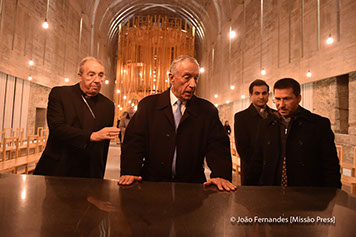
The President of the Republic
has visited the Imaculada Chapel
Chronicle of a special visit
Marcelo Rebelo de Sousa, the President of the Portuguese Republic, has visited the Imaculada Chapel on november 25th, in the context of a journey dedicated to the city of Braga. This particularly busy afternoon started off with a visit to the Academic Clinical Center (2CA-Braga), on the premises of the Hospital de Braga, which currently hosts more than one third of the clinical trials carried out in Portugal. Despite his agenda, the President made time to enter and contemplate the Imaculada Chapel, at the Seminary of Nossa Senhora da Conceição.
The President made time and had the urge. In fact, the staff of the cultural affairs of the Presidency had expressed an interest that the tour could include a visit to the Chapel. This interest was immediately welcomed as a sign of honor and distinction. Having been invited as a speaker to the 1st Missionary Forum of the Archdiocese of Braga, that took place at the Vita Auditorium, promoted by the Missionary Center of the Archdiocese, Mr. Sousa spoke at the opening conference, intitled «What unites us all», as did D. Jorge Ortiga, the Archbishop of Braga, both moderated by Professor Felisbela Lopes.
The Imaculada Chapel is just across the Vita Auditorium. Having that and the request of the staff in mind, Mr. Sousa clearly could not miss the oportunity. He promptly crossed Agora, the covered courtyard, and entered the Chapel through the side door. Upon entering, he was excited and immediately recognized the Lady of Humility, saying: «Look, the Lady!» Thus, he manifested prior knowledge of her existence and meaning. And, repeatedly, he would continue to express his appreciation for the sculpture, which he considered to be very beautiful.
He then looked up and was extraordinarily surprised – overwhelmed, one might even say – not only by the beauty of the cement vault (with over 130 tons suspended), but also by the architecture of the Cheia de Graça Chapel, in wood. Having thought that the work had been signed by Finnish architects, Father Joaquim Félix, who took part in the tour as a guide, reordered the information, explaining that in fact there is a text on the Chapel, written by Asbjørn Andresen, «Our ears have been blinded, the serenity of the space we don’t see», whose reflection originated in a metaphor coined by Finnish architect Juhani Pallasmaa, regarded as one of the most important critics of contemporary architecture, if not the most important. Nevertheless, the authors of this work are architects Cerejeira Fontes, in collaboration with a multidisciplinary work team, whose members, Asbjørn Andresen, Lisa Sigfridsson, Fr. Joaquim Félix and others, work together since the Tree of Life Chapel project.
Mr. Sousa then felt drawn to the altar, from which the sound of living water could be heard. And, as he went towards it, a few encouraging words were addressed to the Archbishop, to whom he praised for the boldness of such a space, in the following terms: «Mr. Archbishop, all style is avant-gard!». Such an optimism is inherent to the Christian faith, whose mission is to sow eternity in the path of every man. This then led the President to ask for the tabernacle, shown in one of the side recesses. It is a filigree work made out of linden wood, enlightened with a tree of life at the bottom and two flying eagles on the portals. In the clasp of the latter, a cross between stars is carved, as is usual in islamic architecture. Having contemplated and touched the altar, a black granite stone floating over water, Mr. Sousa turned to the instalation Body of Light, a piece of marble without frames from Estremoz, to admire the suspension and freedom of such work of art, that surpasses the symbolic of the Resurrected Christ as it concentrates the light in its body and illuminates all the space.
From the instalation, passing by the penta-icon of the Lady of Tenderness, by Swedish painter Lisa Sigfridsson, the group descended towards the sculpture of Our Lady of Humility, to meet her gaze and be in her company. Sitting next to her, Fr. Joaquim Félix recalled other special visitors, such as the (honorary) organist of Notre-Dame of Paris, Jean-Pierre Leguay and wife. And François Nicolas, French composer and Associate Professor of the École Normale Supérieure de Musique of Paris, who came with them in the context of a visit promoted by Fr. Hermenegildo Faria, who associated with Asbjørn Andresen for the presentations of the Chapels. At the end of the day, the visitors were truly amazed (note that that morning they had visited the Tree of Life Chapel) and considered the sculpture of Our Lady of Humility to be the artistic creation that surprised them the most, both by the ethical (as in worthy of being believed) dignity embodied, and by the paradigmatic scope radiating from the theological and relational positioning in space. A very moved François Nicolas asked Asbjørn Andresen, author of the sculpture, with admiration and curiosity: «How is this happening in Braga? What is the basis of such new paradigms for the Church?» To these and other questions Asbjørn Andresen, taking his time, broke the silence with yet another question: «Why was Jesus born in Bethlehem?».
Reporting this special visit is also realizing that the answer to all these questions lies within each one of us. Bearing this in mind, a smile appeared on every face and the visit to the Chapel came to an end.
Texto: Filipe Alves
Fonte das fotografias e créditos:
Auditório Vita / João Fernandes [Missão Press]:
https://www.flickr.com/photos/131691162@N04/
Página Oficial da Presidência da República Portuguesa:
http://www.presidencia.pt/?idc=10&idi=118372